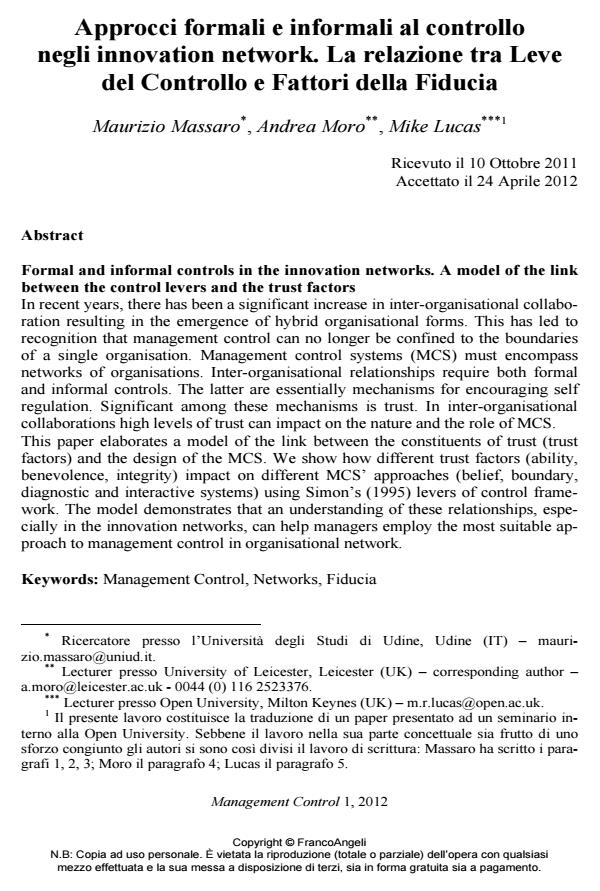Formal and informal controls in the innovation networks. A model of the link between the control levers and the trust factors
Journal title MANAGEMENT CONTROL
Author/s Maurizio Massaro, Andrea Moro, Mike Lucas
Publishing Year 2012 Issue 2012/1
Language Italian Pages 28 P. 27-54 File size 687 KB
DOI 10.3280/MACO2012-001003
DOI is like a bar code for intellectual property: to have more infomation
click here
Below, you can see the article first page
If you want to buy this article in PDF format, you can do it, following the instructions to buy download credits

FrancoAngeli is member of Publishers International Linking Association, Inc (PILA), a not-for-profit association which run the CrossRef service enabling links to and from online scholarly content.
In recent years, there has been a significant increase in inter-organisational collaboration resulting in the emergence of hybrid organisational forms. This has led to recognition that management control can no longer be confined to the boundaries of a single organisation. Management control systems (MCS) must encompass networks of organisations. Inter-organisational relationships require both formal and informal controls. The latter are essentially mechanisms for encouraging self regulation. Significant among these mechanisms is trust. In inter-organisational collaborations high levels of trust can impact on the nature and the role of MCS. This paper elaborates a model of the link between the constituents of trust (trust factors) and the design of the MCS. We show how different trust factors (ability, benevolence, integrity) impact on different MCS’ approaches (belief, boundary, diagnostic and interactive systems) using Simon’s (1995) levers of control framework. The model demonstrates that an understanding of these relationships, especially in the innovation networks, can help managers employ the most suitable approach to management control in organisational network.
Keywords: Management Control, Networks, Fiducia
- Accounting Information Systems in an Open Society. Emerging Trends and Issues Daniela Mancini, in MANAGEMENT CONTROL 1/2016 pp.5
DOI: 10.3280/MACO2016-001001 - Gestione integrata dei dati e misurazione della performance nei network inter-municipali: un'analisi sistematica della letteratura Luca Mazzara, Francesco Bergamaschi, Giulia Leoni, in MANAGEMENT CONTROL 2/2022 pp.91
DOI: 10.3280/MACO2022-002005 - Inter-firm coordination as an Information problem. The case of a divisionalized company Antonio Leotta, in MANAGEMENT CONTROL 2/2016 pp.167
DOI: 10.3280/MACO2016-002008 - How Italian companies are monitoring innovation Anna Arcari, Anna Pistoni, Enrico Moretto, Paolo Ossola, Daniele Tonini, in MANAGEMENT CONTROL 2/2016 pp.143
DOI: 10.3280/MACO2016-002007
Maurizio Massaro, Andrea Moro, Mike Lucas, Approcci formali e informali al controllo negli innovation network. La relazione tra Leve del Controllo e Fattori della Fiducia in "MANAGEMENT CONTROL" 1/2012, pp 27-54, DOI: 10.3280/MACO2012-001003